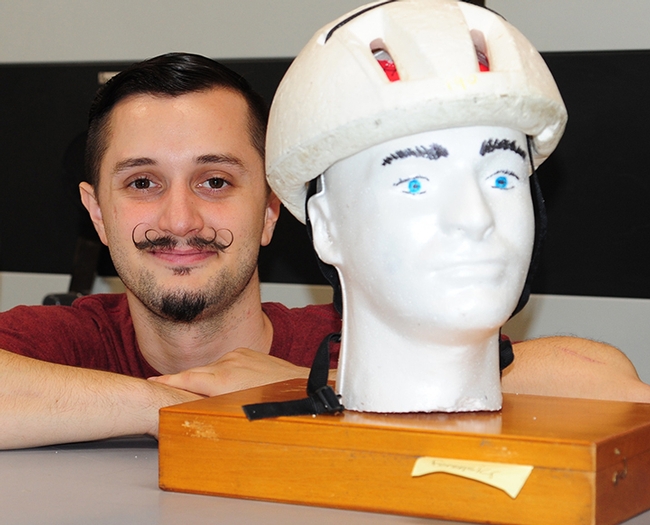- Author: Kathy Keatley Garvey
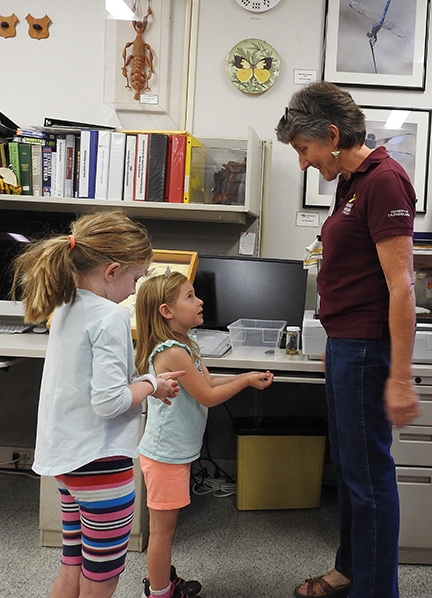
Fact: At least 80 percent of those attending the Bohart Museum of Entomology's open house on entomophagy ate one or more insects--a cricket, an earthworm or a mealworm. The diners ranged in age from a 9-month-old girl to senior citizens.
Some came back for more--especially the mealworms and earthworms, said Bohart associate Emma Cluff. The crickets? Not so much.
A two-year-old from Dixon happily munched everything given to him. "He'll eat anything," his mother said.
Various companies, including Hotlix, Exo and Chirps Chips, provided the samples.
Besides eating insects, visitors asked questions about entomophagy and handled insects from the petting zoo, which includes Madagascar hissing cockroaches, walking sticks or stick insects, and tarantulas.
They also made buttons proclaiming "I Ate a Bug at the Bohart."
A display, titled "Bug Buffet," drew widespread interest: "Have you ever eaten ant pancakes or scorpion scaloppini? Well, eating bugs (entomophagy) is a lot more common than you might think. All round the world, people eat delicious and nutritious insect delicacies."
The dishes mentioned on the display:
- Locust Biscuits, featuring the brown locust, Locustana pardalina
- Mexican Caviar, starring the giant water bug, Abedus herberti
- Termite a la Carte, featuring termites, order Isoptera
- Maguey Worm Tacos, with Maguey worms, family Megathymidae
- Raw Cossid Moths, starring the larvae of the cossid moth, Xyleutes leucomochia
- Fried Pupae, presenting the pupae of the silkworm moth, Bombix mori
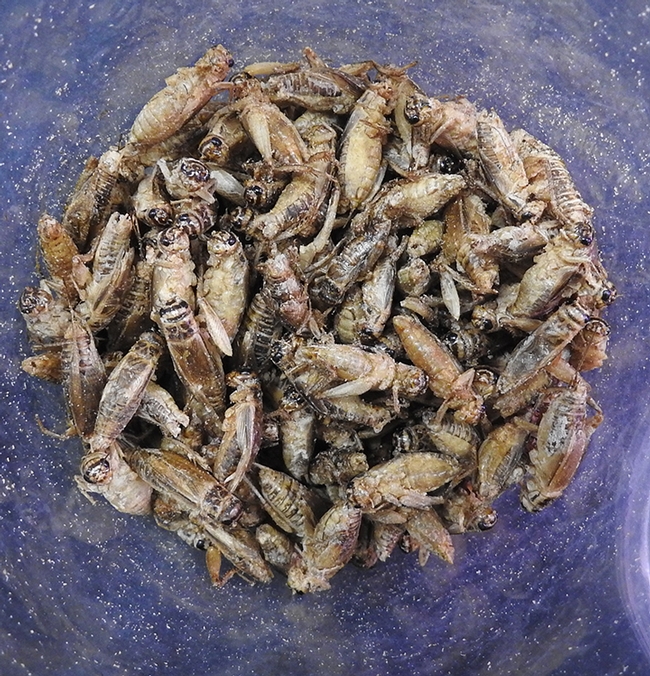
The next Bohart Museum open house, themed Parasitoid Palooza!, is on Saturday, Oct. 19 from 1 to 4 p.m. It is free and family friendly. The museum is located in Room 1124 of the Academic Surge Building on Crocker Drive.
"An insect parasitoid is a species whose immatures live off of an insect host, often eating it from the inside out," said Tabatha Yang, education and outreach coordinator of the Bohart Museum. "It is part of their life cycle and the host generally dies."
The late UC Davis entomologist Richard M. Bohart (1913-2007), founder of the Bohart Museum, researched Strepsiptera, or twisted-wing parasites, for his doctorate in 1938. Both the Bohart Museum and an entire family of Strepsiptera, the Bohartillidae, are named in his honor.
The Bohart Museum, directed by Lynn Kimsey, UC Davis professor of entomology, houses a global collection of nearly eight million specimens. It is home to the seventh largest insect collection in North America, and the California Insect Survey, a storehouse of the insect biodiversity. It also maintains a year-around gift shop, which is stocked with T-shirts, sweatshirts, books, jewelry, posters, insect-collecting equipment and insect-themed candy.
The insect museum is open to the public Mondays through Thursdays from 9 a.m. to noon and 1 to 5 p.m., except on holidays. More information on the Bohart Museum is available on the website at http://bohart.ucdavis.edu or by contacting (530) 752-0493 or bmuseum@ucdavis.edu. (See list of open houses for the 2019-2020 academic year.)
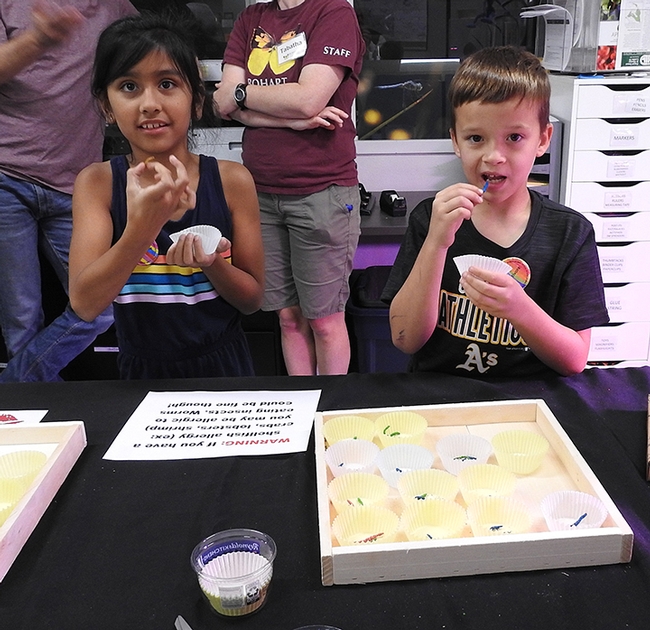
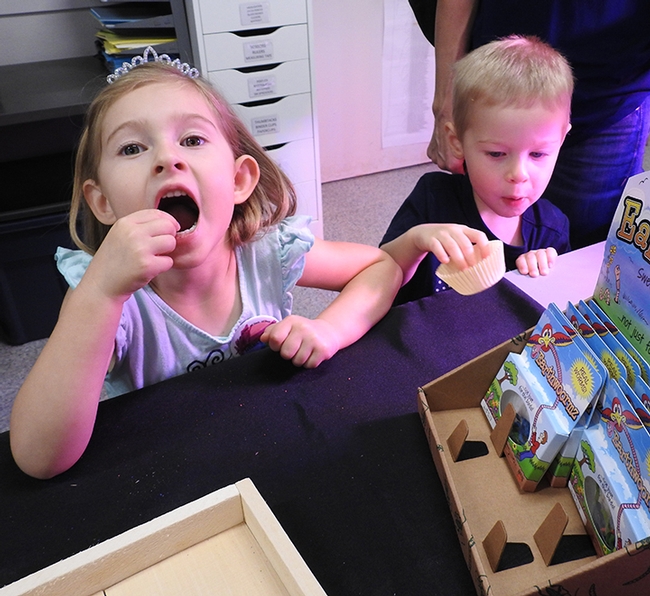
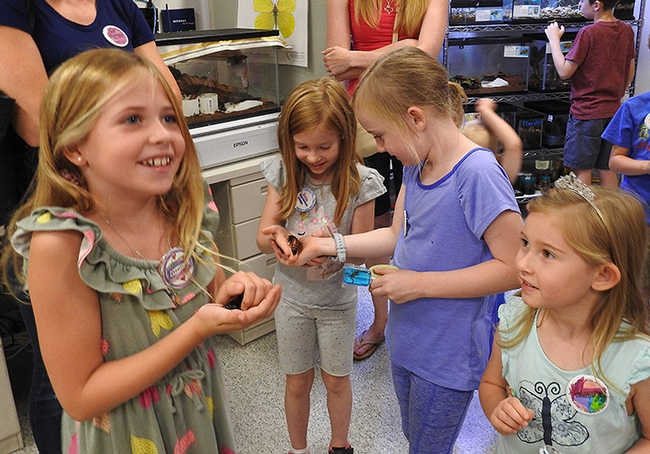
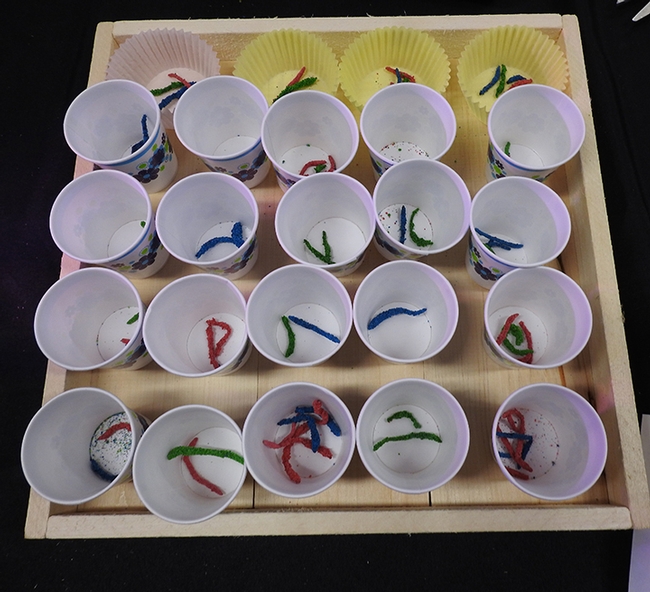
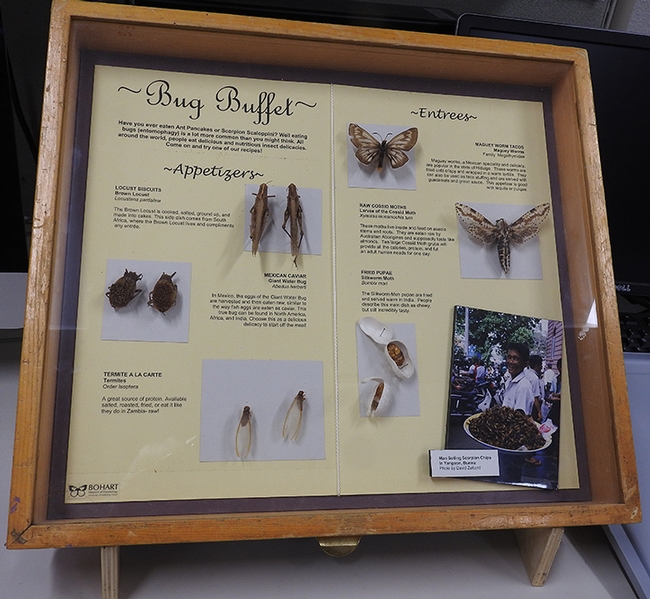
- Author: Kathy Keatley Garvey
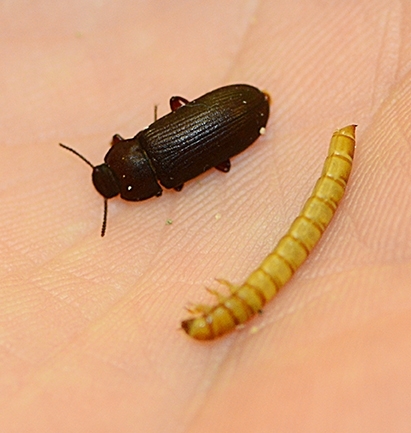
And if you attended the UC Davis Bohart Museum of Entomology open house on Dec. 5, 2015, you may have seen entomology student Wade Spencer showing visitors the larvae devouring his Styrofoam bicycle helmet.
And if you've been following the news from Environmental Protection Agency (EPA), you may have heard about the UC Davis doctoral student who just received a $15,000 grant in EPA's National Student Design Competition for Sustainability Focusing on People Prosperity and the Planet (P3).
That would be Trevor Fowles, a second-year doctoral student in the UC Davis Department of Entomology and Nematology, who submitted his research project, “Beetle Larvae as Biodegraders of Styrofoam and Organic Waste.” He now has an opportunity to score a $75,000 grant in Phase 2 of the competition. He'll be in Washington DC April 7-8 for the National Sustainable Design Expo at the Science and Engineering Festival.
Meanwhile, his 100,000 mealworms in the Briggs Hall lab of his major professor Christian Nansen, are munching up a storm (well, a blizzard of the white stuff) in a project that Fowles hopes will make a difference in breaking down Styrofoam--especially a problem in the nation's landfills--and offer sustainable environmental solutions.
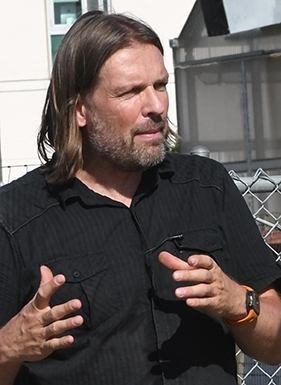
“It's about insects processing waste,” Fowles said of his research. “In three weeks they ate three-fourths of a pound of styrofoam, converting it into biodegradable waste.”
“Trevor's project should be viewed as an example of what entomological agricultural research is all about in the 21st Century--developing new and highly innovative ways to recycle resources and more sustainable food production systems," said agricultural entomologist Christian Nansen, an associate professor of entomology who specializes in applied insect ecology, integrated pest management (IPM) and remote sensing. In addition, the project has an applied evolutionary angle, which Fowles intends to explore.
"Our plan is to selectively breed insects and their microbial gut biome, so that they become highly adapted to breakdown, not only Styrofoam, but also different kinds of agricultural waste products," Nansen said. "Similar to orchard growers bringing in bee hives during flowering periods for pollination, we envision that, in the future, companies will be able to order strains of insects for biodegradation of specific wastes. That is, the future of applied entomology will in different ways be about identifying and developing ways for insects to provide different societal services, including pollination, biological control, and biodegradation."
The UC Davis research project involves designing a pilot-scale styrofoam biodegradation unit to take in regional Styrofoam and organic waste, and establish a high-performance beetle lineage, or the “best beetle larvae to do the job.” The adult beetles also eat Styrofoam, but not as much.
“Organization of our food systems will be a defining challenge in the upcoming century and I believe insects will play a significant role in transforming our agricultural sectors,” Fowles said.
The design emphasizes economic feasibility, community engagement, and environmental stewardship. To be sustainable, the project is aimed at connecting local community stakeholders with research expertise to produce an ecofriendly alternative for Styrofoam disposal.
After biodegrading the Styrofoam, the beetles can be pelletized for animal feed, Fowles said, and the excrement or frass can be used as “high-value amendment to compost mixtures.” He figures that that since Styrofoam by itself is a poor nutrient source for the beetle larvae, he eventually will mix it with organic waste materials, such as, pulp from wine and tomato industries, to optimize beetle development.
The darkling beetles and larvae are pests of stored grains, but the larvae are widely used throughout the world as food for humans; for captive pets, including fish, reptiles and birds; and as fish bait. They are reared commercially on fresh oats, wheat bran or grain, and often with sliced potato, carrots, or apple as a moisture source.
In the wild, darkling beetles and larvae are general decomposers, eating decaying leaves, sticks, grasses, and carcasses.
Fowles said he received his first colony of mealworms in 2016 from then graduate student Tom Nguyen at the Bohart Museum of Entomology (Nguyen is now a researcher at the Smithsonian Institution). Fowles purchased his 100,000 mealworms from the insect farm, Rainbow Mealworms and Crickets in Compton.
Fowles, who grew up in West Sacramento, received his bachelor's degree in biology in 2011 from San Diego State University. Before entering the UC Davis graduate student program, he served as a lab manager for five years for Carroll/Loye Biological Research, launched by the UC Davis entomological team of Scott Carroll and Jenella Loye.
In a news release, EPA Administrator Scott Pruitt said: “This year's P3 teams are applying their classroom learning to create valuable, cutting-edge technologies. This next generation of scientists is designing sustainable solutions that will help protect public health and the environment and ensure America continues to lead the world in innovation and science for decades to come.”
Fowles obtained his first colony of mealworms in 2016 from then graduate student Tom Nguyen at the Bohart Museum of Entomology, now a researcher at the Smithsonian Institution. Fowles purchased his 100,000 mealworms from the insect farm, Rainbow Mealworms and Crickets in Compton.
The project in the Christian Nansen lab is all good news for the environment. Who would have thought that beetle larvae would chow down on Styrofoam, the stuff that fills our landfills and what holds our coffee and take-out orders?
Stanford researchers say that every year we Americans throw away 2.5 billion plastic foam cups alone. And that's just a fraction of the 33 million tons of plastic that Americans discard every year. Another statistic: less than 10 percent of that total gets recycled. And as a Stanford news release indicated "the remainder presents challenges ranging from water contamination to animal poisoning."
Bring on the high-performance UC Davis beetles!
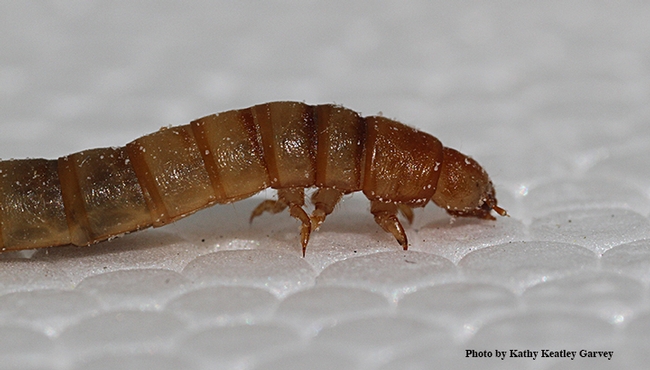
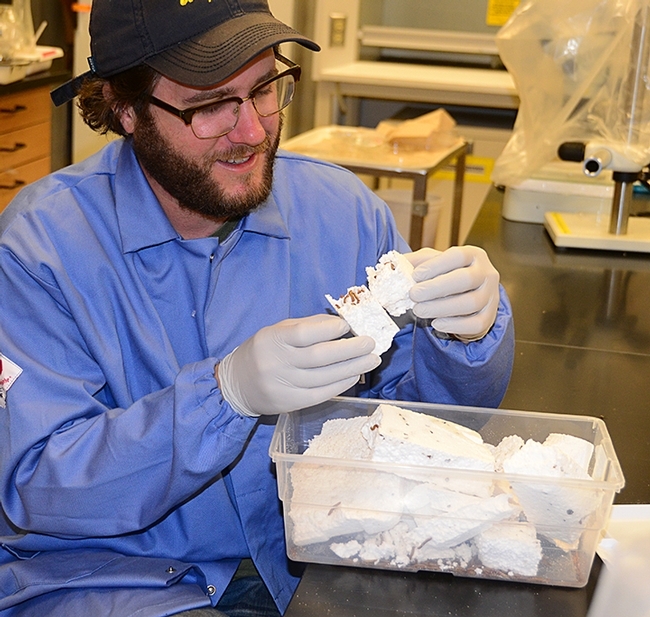
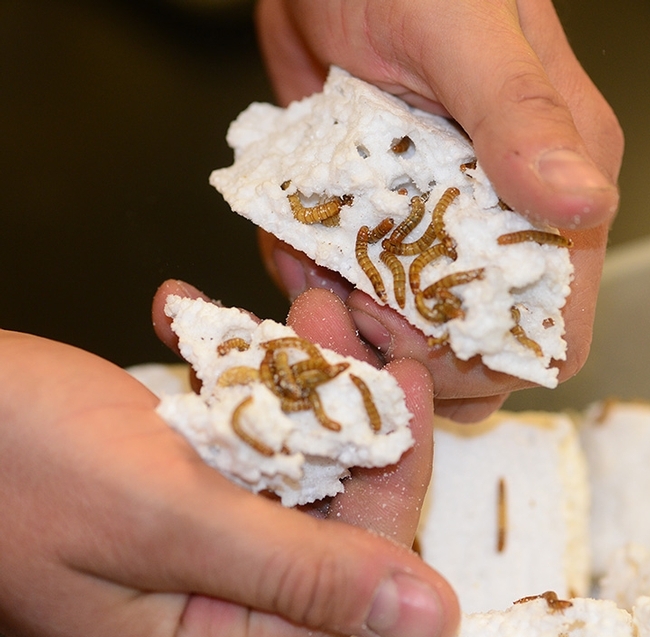
- Author: Kathy Keatley Garvey
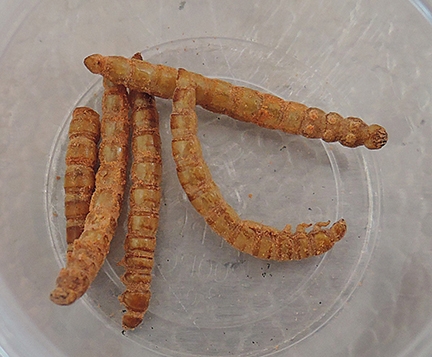
Drum roll...Time's up...
If you answered "mealworms"--or the larval form of the darkling beetle, family Tenebrionidae--that's correct.
And if you visit the UC Davis Bohart Museum of Entomology's open house ("Keep Calm and Insect On") from 1 to 4 p.m., Saturday, Dec. 5 in Room 1124 of the Academic Surge building, Crocker Lane, you'll encounter them chewing on a Styrofoam head, "The Recycling Man."
“It turns out that mealworms have some hidden talents,” said Lynn Kimsey, director of the Bohart Museum and professor of entomology at UC Davis. “They're not just good for feeding to pet reptiles or eating in snacks from HotLix. “These darkling beetle larvae have some dynamic gut bacteria.”
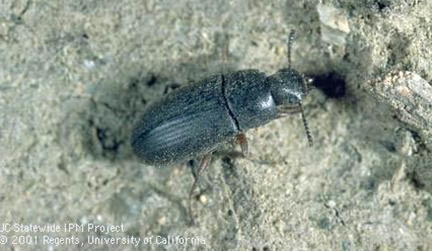
Enter Entomology undergraduate student Wade Spencer. You may know him from Bohart Associate Fran Keller's video of him costumed as a peacock jumping spider and performing a courtship dance. That video drew more than 2 million hits. (See previous Bug Squad piece on Wade Spencer with a link to Keller's video, or visit the Bohart Museum's Facebook page.)
So for his project, Spencer purchased a Styrofoam head online, obtained a Styrofoam insert from a bicycle helmet, and inserted 60 mealworms. That was on Nov. 18. Meanwhile, they're munching away. “Listen and you can hear them chewing," he said.
"This is a recycling project that's all in the head,” Spencer quipped.
(Learn more about darkling beetles on the UC Integrated Pest Management Program's website.) The insects can be pests of squash, pumpkins, dry beans and figs and the like. The wormlike larvae are commonly eaten by folks engaging in entomophagy.
Also at the Bohart Museum open house on Dec. 5, it's a time for show and tell. Bring insect or spider specimens and ask questions of the entomologists.
Native pollinator specialist Robbin Thorp, UC Davis distinguished emeritus professor of entomology at UC Davis, will be available for discussions on bumble bees and other pollinators, and will sign his books. He is the co-author of “Bumble Bees of North America: An identification Guide” (Princeton University) and “California Bees and Blooms: A Guide for Gardeners and Naturalists” (Heyday).
The Bohart Museum houses a global collection of nearly eight million specimens. It is also the home of the seventh largest insect collection in North America, and the California Insect Survey, a storehouse of the insect biodiversity. Noted entomologist Richard M. Bohart (1913-2007) founded the museum. Special attractions include a “live” petting zoo, featuring Madagascar hissing cockroaches, walking sticks and a rose-haired tarantula named “Peaches.” Visitors are invited to hold the insects and photograph them.
The museum's gift shop, open year around, includes T-shirts, sweatshirts, books, jewelry, posters, insect-collecting equipment and insect-themed candy.
The Bohart Museum hosts special weekend open houses throughout the academic year. All are free and open to the public and families are encouraged to attend. The regular hours are from 9 a.m. to noon and 1 to 5 p.m. Mondays through Thursdays. The museum is closed to the public on Fridays, Saturdays and Sundays and on major holidays. There is no admission but donations are appreciated.
More information on the Bohart Museum is available by contacting (530) 752-0493 or email bmuseum@ucdavis.edu. Tabatha Yang (tabyang@ucdavis.edu) does public education and outreach and conducts groups tours.
